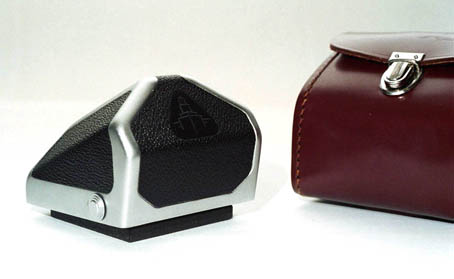 |
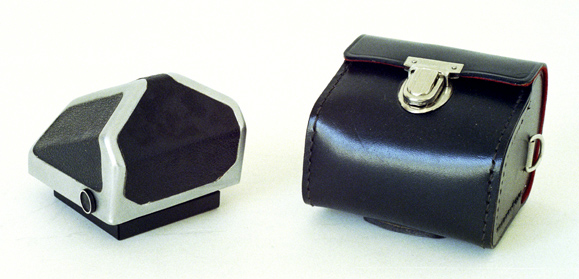
The new-style Pentacon Six plain prism, also supplied in a smart leather case. Note that the changing dictates of style resulted in this newer case being in black leather, while the older one was in brown. [C414-4A] |
Pentaprisms
Plain prisms
Praktisix/Pentacon Six
From soon after the introduction of the Praktisix, a non-metering prism was available, and with slight variations this continued to be available for the Pentacon Six, so plain prisms are not difficult to find. A few years later, an improved version of this prism was produced: a coated condenser lens on the lower part of the prism was apparently intended to brighten the viewfinder image substantially, although I can’t see any difference – whether with the standard focussing screen in the camera or the much brighter Rollei screen!
It is easy to spot whether the prism is of the older or newer
design,
by looking at the button on each side of the prism that locks it
onto the
camera: the original design has “silver” (bright aluminium)
buttons,
while the newer prism has black ones.
 |

The new-style Pentacon Six plain prism, also supplied in a smart leather case. Note that the changing dictates of style resulted in this newer case being in black leather, while the older one was in brown. [C414-4A] |
The prism on the Norita 66 seems to me largely inspired by the
shape
of this prism – although there are of course obvious constraints
on the
possible shape of pentaprisms. To see a comparison of the
Pentacon
Six and the Norita click here.
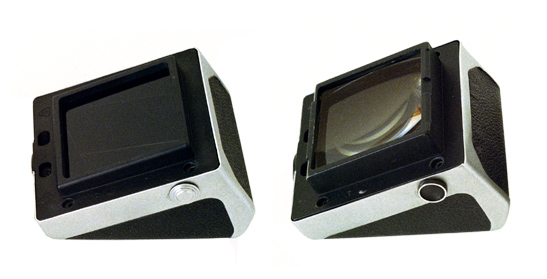 [C414-8A] |
| The older of these two prisms has in the casting of its
base the KW
logo of Kamera-Werke Niedersedlitz, Dresden, the designers
and manufacturers
of the Praktisix. KW had already been taken into
State ownership
by the Communist government of the GDR but still used
their own logo and
their own brand names (for instance, Praktina and
Praktisix) on the equipment
that they made.
[C419-30] |
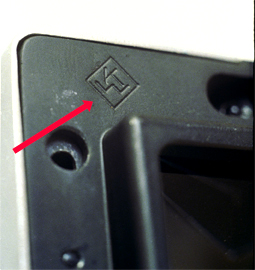 |
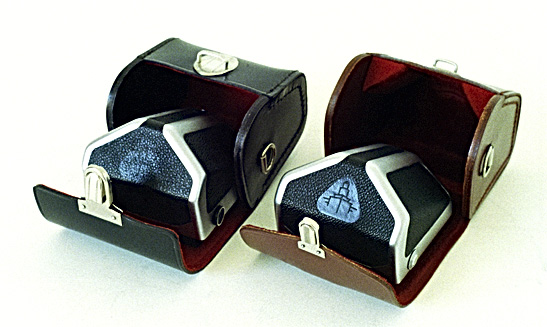 It is ironic that in these two examples of the prism, the Pentacon symbol of the Ernemann Tower is clear and sharp on the leather trim applied to the old KW prism (here on the right!), but fuzzy on the newer (Pentacon Six) prism, which no longer has the KW logo on its base. The older prism was obviously produced when the Pentacon name was first introduced, and used existing KW stock. Looking at the two cases in this picture, it can also be seen that more time and care went into the manufacture of the older case, which has a shaped insert to cushion the prism better. The original KW prism for the Praktisix did not normally have any logo at all on the leather – although I am grateful to Heinz Schrauf for a picture of a rare Praktisix prism with the KW logo on the leather:
|
Kiev 60 / Kiev 6C
In the 60s and early 70s Arsenal produced a non-metering prism
for the
Kiev 6C, which was the precursor of the Kiev 60, but these prisms
are extremely
rare. The non-metering prism is not as tall as the Kiev 60
metering
prism.
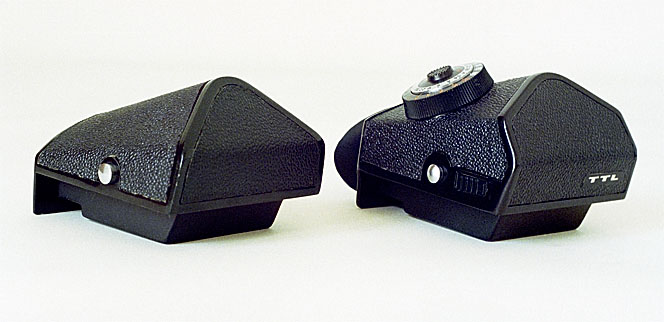
[C436-6] The plain prism obviously lacks both the on-off switch and the metering dial of the TTL prism |
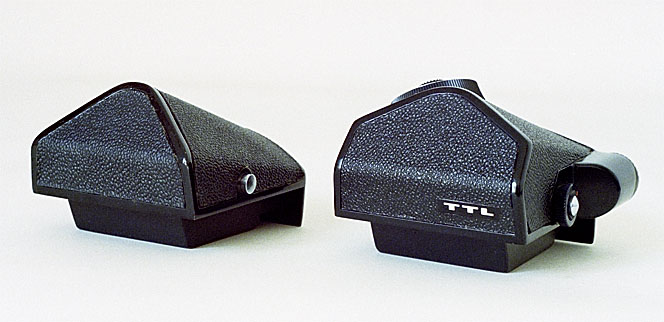
[CC436-5] The view from the other side shows, of course, the absence of a battery compartment |
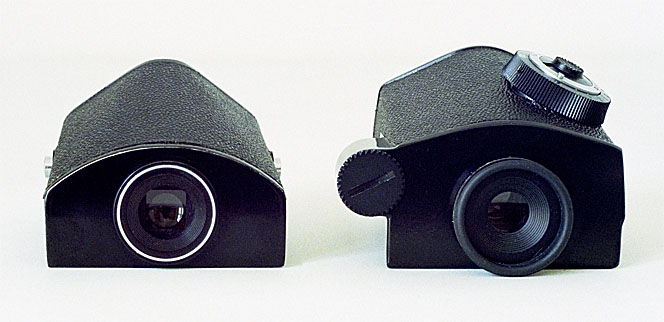
[C436-7] Rear view of the Arsenal plain and metering prisms for the Kiev 6C/60 |
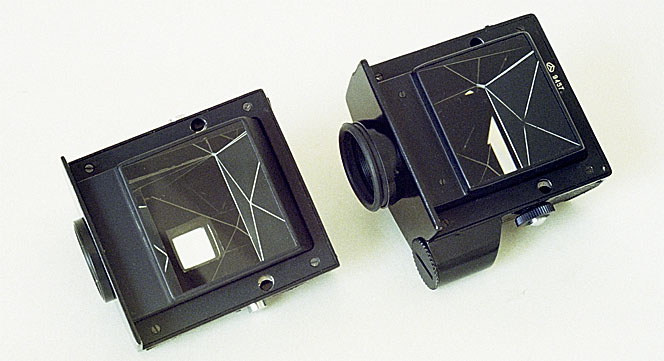
[C436-8] The underside of the two prisms reveals that optically they are apparently identical. Note that the non-metered prism does not have a serial number. |
In use on the Pentacon Six, via the Baierfoto adapter, the Kiev Arsenal plain prism has the same two advantages as the Kiev Arsenal metering prism:
Exakta 66
Exakta produced a very smart low-profile non-metering prism for
the
Exakta 66. This is on rare occasions offered on the
internet.
Inside, it contains what looks like an unmodified Pentacon Six
plain prism.
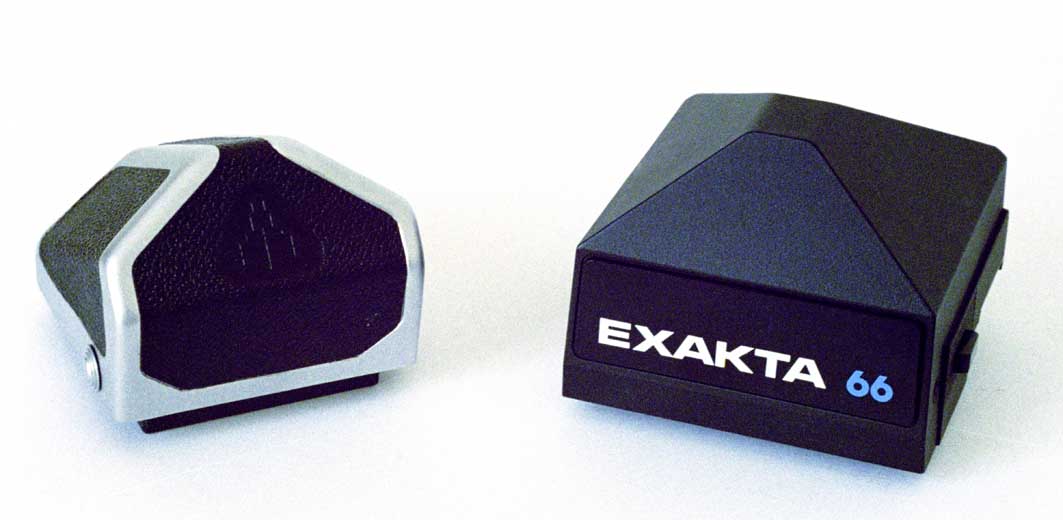
[C371-34A] |
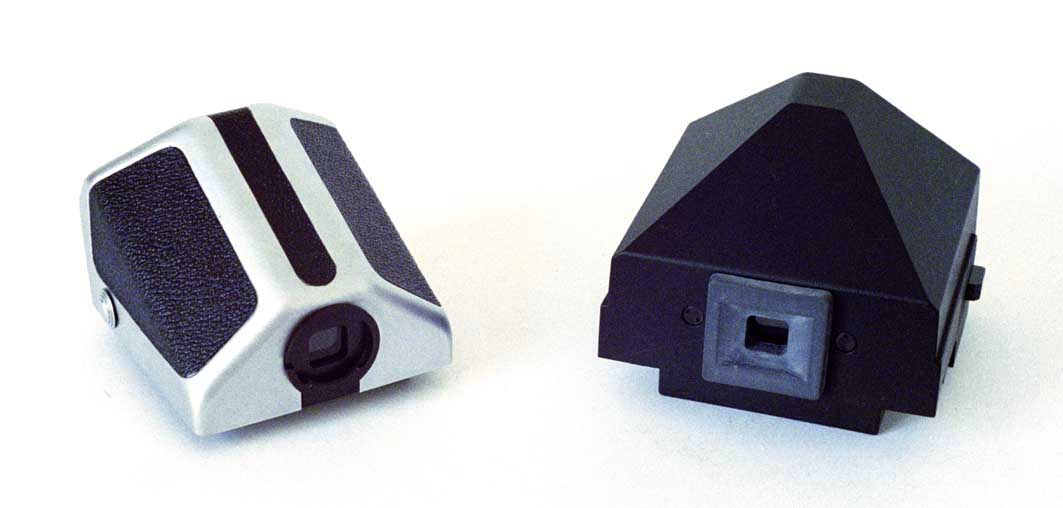
Rear view of the same prisms [C371-35A] |
Accessory socket on Pentacon Six and Exakta 66 prisms
These prisms have a mounting socket often referred to as “big
ears”,
because of the shape of the bayonet mounting on the
accessories.
You can see that mount on an accessory here.
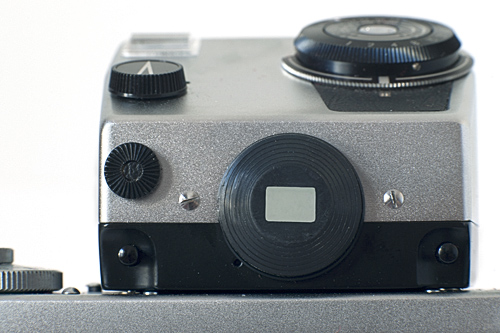
[prismeyep1.jpg] When supplied new, the Pentacon Six prisms were delivered with a rubber protector that prevented spectacles from being scratched by the eyepiece. I don’t know why the opening in this is rectangular and not square, but in practice it permits a full view of the image, so this is not significant. |

[prismeyep3.jpg] If the rubber spectacles-protector is removed, one can see the “big ears” mounting socket designed to accommodate a range of viewfinder accessories. When buying a prism, I always look for one with the spectacles-protector. |
Kiev 88-6 (Kiev “B.i.G.-Six”) / Kiev 88CM
Arsenal have manufactured a small and
light-weight
non-metering prism for the Kiev 80/Kiev 88/Salyut (also marketed
in the
U.K. as the Zenith 80), and some users love it, but it is not
easy to find
one. No Kiev 88 prism can be mounted on a Pentacon
Six and I do not believe that any adapter exists to make
this possible.
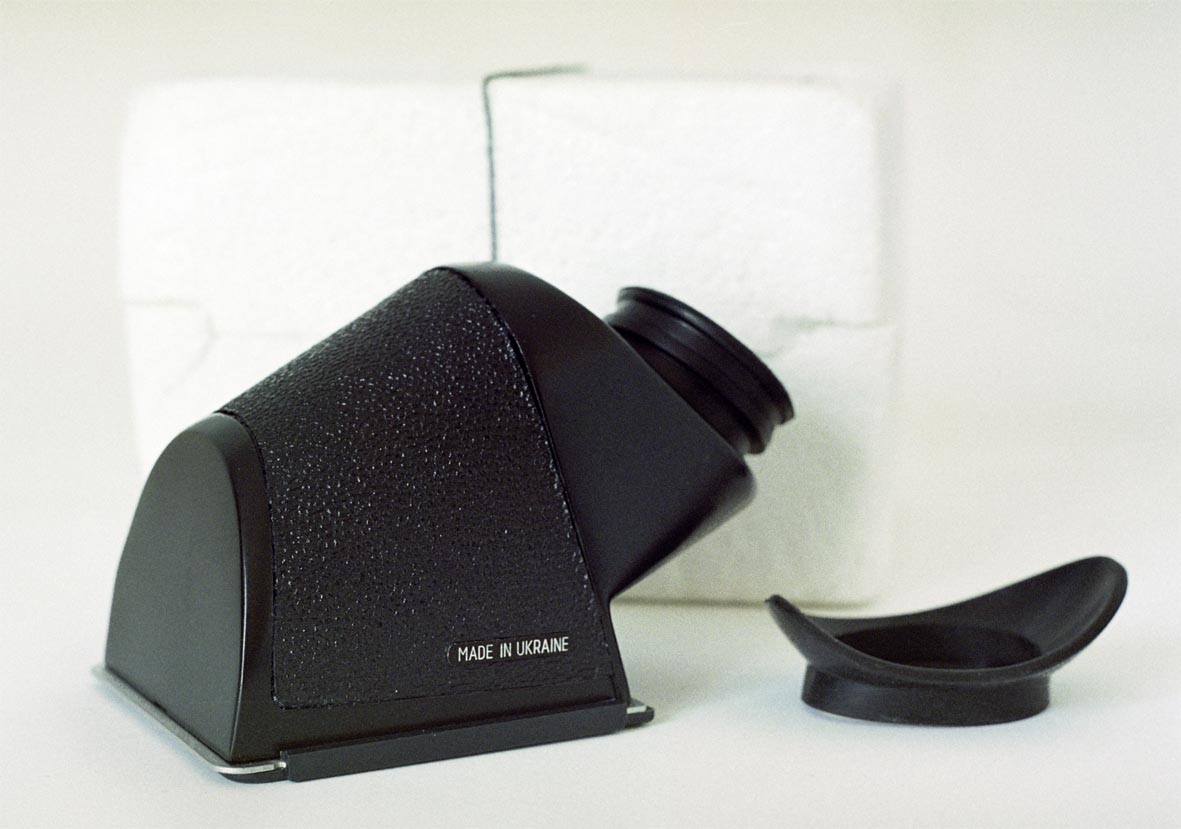
[C442-15A] The Arsenal plain prism for the Kiev 88 This is clearly inspired by the Hasselblad NC-2 plain prism |
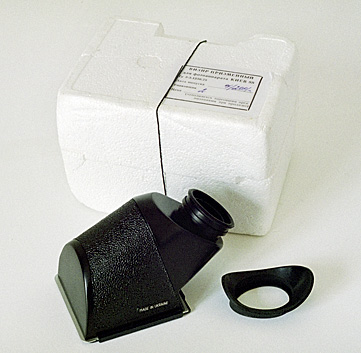
[C442-16A] The plain prism as supplied new in its moulded polystyrene box A protective base plate and a rubber eye-cup are supplied with the prism. |
Note that this prism is labelled “Made in Ukraine”, which dates the label, at least, at after the dissolution of the former Soviet Union. Plain prisms do not have a serial number, which – in the case of FSU products – normally indicates the year of manufacture. Like the Hasselblad NC-2 prism, the Arsenal plain prism provides 3× magnification of the focussing screen image.
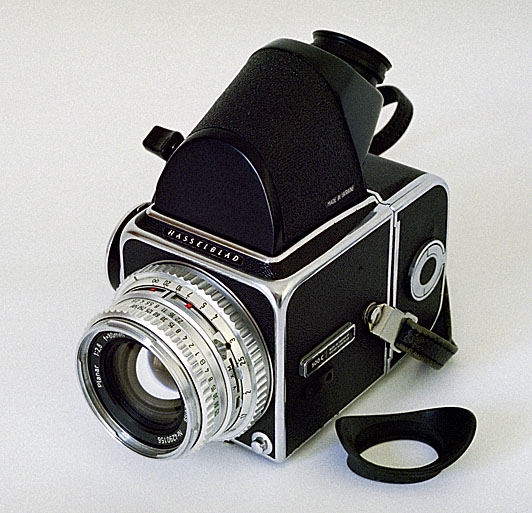
[C442-17A]
The Arsenal plain prism mounted on a Hasselblad 500C
Metering Prisms
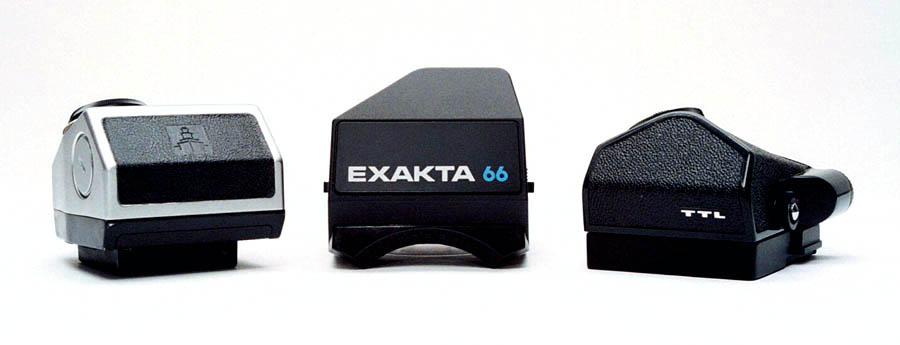
[C309-8] TTL metering prisms: L to R: Pentacon Six, Exakta 66,
Kiev
60
Pentacon Six
In 1968 Pentacon introduced a TTL meter prism for the Pentacon
Six,
which was henceforth called the “Pentacon Six TL”. This
extremely
reliable and easy-to-operate prism provides both full aperture and
stop-down
metering, though I consider that using the stop-down approach is
much easier
and faster to use. The meter is not coupled to lens aperture
or shutter
speed. It is criticised by some for not being very bright,
although
I find it more than adequate when used with the Pentacon fresnel
screen
or the Rollei screen. It is also criticised for having too
wide a
“safety margin”; it just doesn’t show enough of the image on the
focussing
screen. However, one adjusts to this, and if one composes
tightly,
the resulting extra fraction round the edges of the image is
rarely a problem,
and does at least allow for photo processors who are often not
very accurate
when framing the negative to be enlarged, or when trimming the
prints.
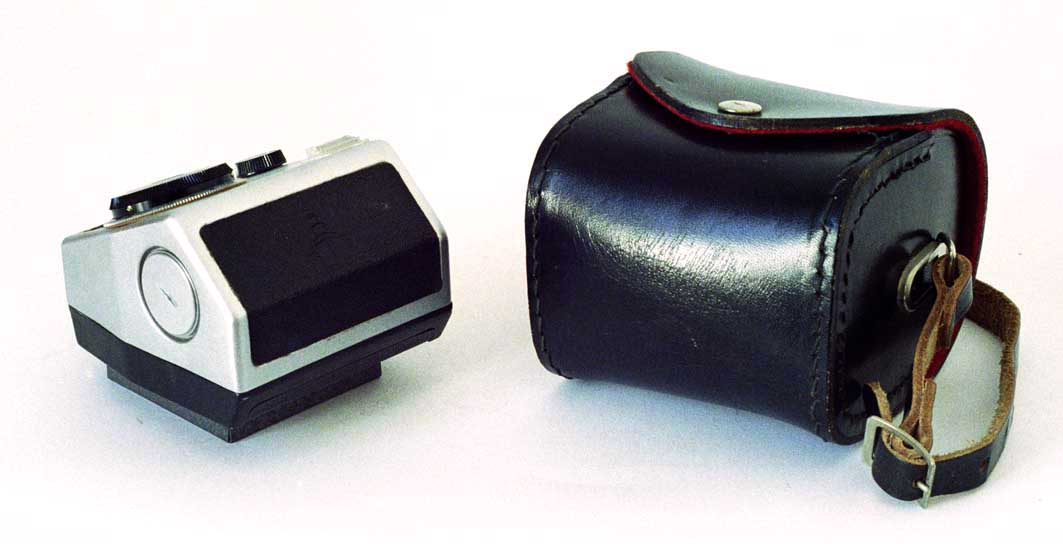
|
When not supplied with the camera, the Pentacon Six metering prism was sold in a smart leather case, and included a protective metal base plate. |
The Pentacon Six TTL prism will fit the Praktisix, the Praktisix II and the Praktisix IIA and will work perfectly with them. It has its own internal clips and so engages well even on the Praktisix and Praktisix II, which do not have the viewfinder locking pin that was introduced with the Praktisix IIA.
You can find instructions on how to use this prism here.
Kiev 60
The Kiev 60 TTL prism is also totally uncoupled, but has two advantages over the Pentacon Six prism:
You can find instructions on how to use this prism here
(scroll down).
Exakta 66
| The Exakta 66 TTL prism is large, expensive and
clever. Inside
its smart grey exterior hides an unmodified (as far as I
can tell) Pentacon
Six prism. But here the similarities end. A
series of gold-plated
contacts on the base of the prism locate with matching
contacts on the
top plate of the Exakta 66 body, to provide full transfer
of shutter speeds
to the electronic metering system.
The front of the prism projects forwards of the front of the camera, and another series of contacts (this time in black) mate with a rotating cam on the Joseph Schneider lenses made for this camera, transferring the value of the aperture selected to the metering prism. In addition, a pin on those Schneider lenses with a maximum aperture other than f/2.8 also tells the meter the maximum aperture of the lens. The result? Open aperture metering fully coupled to the shutter speed and aperture chosen.
|
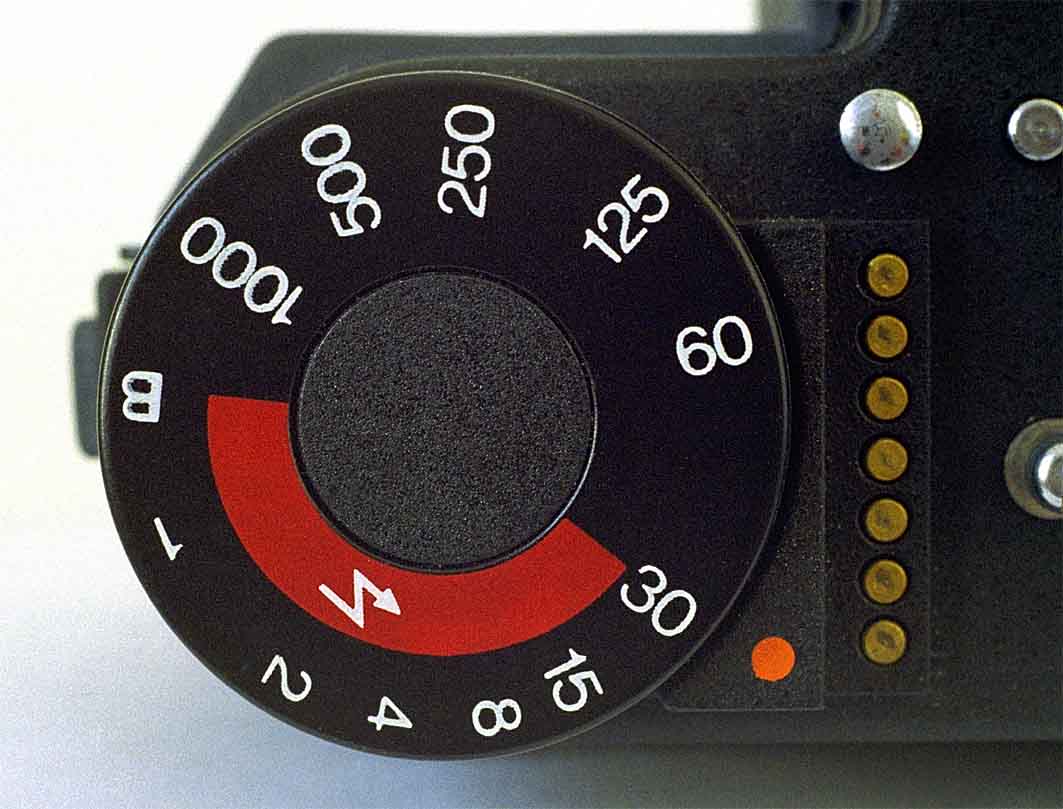
transfer the shutter speed data to the Exakta 66 metering prism |
It is not possible to mount either of the Exakta 66 prisms onto the Pentacon Six.
You can find instructions on how to use this prism here and more information on how it works here.
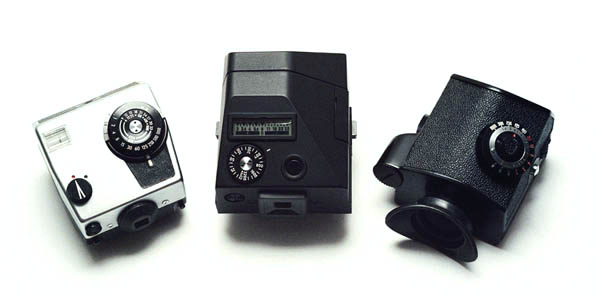
[C309-9] The three TTL prisms viewed from above: L to R:
Pentacon Six,
Exakta 66, Kiev 60
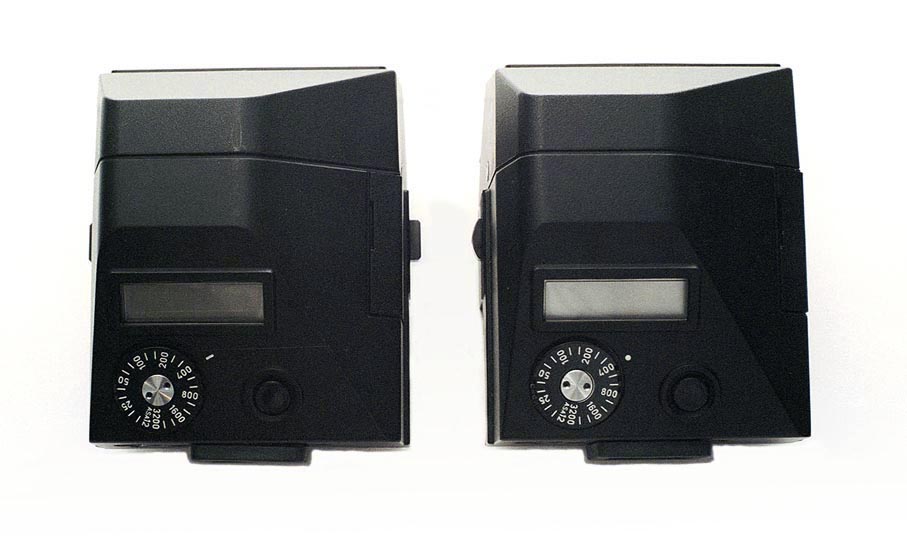
|
When the Exakta 66 Mk II was released, one of the
improvements was
a longer film advance lever. This minor change was
in fact a major
improvement in speed and ease of handing. However,
the tip of the
new longer lever just touches the rectangular release
button on the right-hand
side of the metering prism (viewed from above). In
consequence, this
was re-designed to a lower-profile curved button.
(The right hand button on the newer prism is not visible from this angle, but it is of course the same as the left-hand button.) In fact, there is a third form of the Exakta 66 metering prism, but the differences are not visible without disassembling it. It contains electronic components from a different sub-contractor. |
Stop-down metering with the Exakta 66 TTL prism
See details of this here (scroll down).
Relationship between viewfinder image and image on film, print or screen
The Pentacon Six (and therefore also the Exakta 66) prisms (both
metering
and non-metering) are sometimes criticised for not showing the
whole of
the image area. For a detailed analysis of this, click here
and scroll down to the bottom of the page. Interestingly,
the Pentax
6×7 prism is criticised for exactly the same failing on the Luminous
Landscape
Review, which states that
| “it only shows 90% of the full frame recorded on film. For a 100% view you need to use either the folding hood or the rigid magnifying hood. The downside of these is that they are unsuitable for vertical framing”. |
Kiev 88-6 (Kiev “B.i.G.-Six”)/Kiev 88CM
Arsenal Kiev has produced two metering prisms for the Kiev
88.
Both metering prisms operate essentially in the same way as the
Kiev 60
prism, and therefore they are not coupled to the lens aperture nor
to the
body shutter speed. Only the shape and the mount are
different from
the Kiev 60 prism. Both Kiev 88 prisms are (approximately)
45°
prisms, and I find both of them very comfortable to
use. They
offer stop-down metering only.
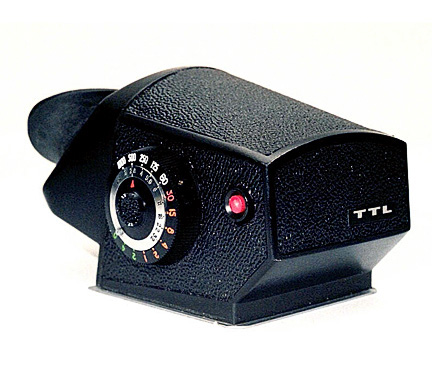
[C311_12.jpg] The original Arsenal plain prism for the Kiev 88 |
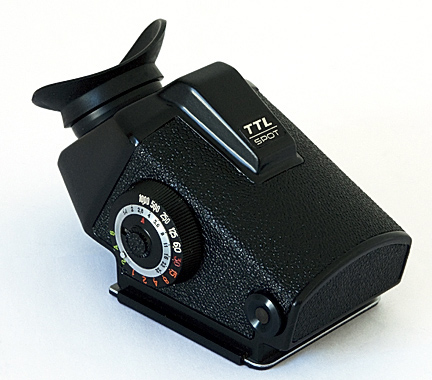
[ttl_spot.jpg] The newer prism is switchable between integrated centre-weighted and spot metering. The results in both modes are absolutely “spot”-on! |
They also have the advantage of fitting Hasselblad cameras.
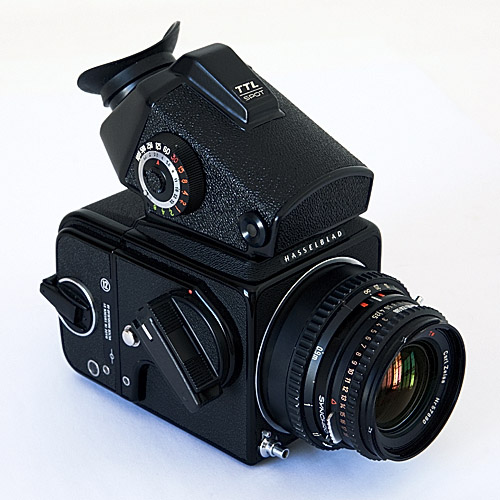
[500wkspot.jpg] The Kiev centre/spot prism looks very smart on the Hasselblad 500 C/M. It compares very favourably to the Hasselblad prism shown on the right. |
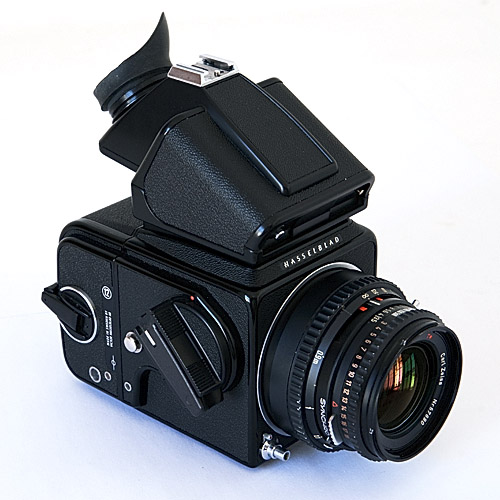
[500whassyp.jpg] This Hasselblad prism has a flash shoe, but that is of course about the worst place to put a flashgun! And it does not offer a spot-metering option. |
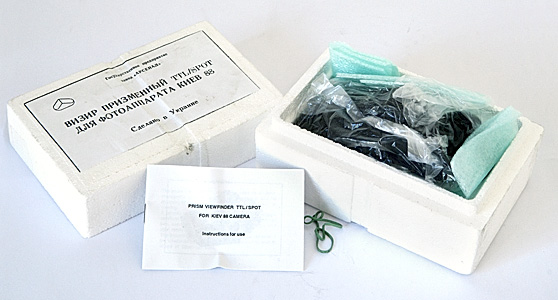
The same as the plain prism, the spot prism is supplied new in a
moulded
polystyrene box,
along with a protective base plate and a rubber eye-cup.
One must assume that money ran out before the manufacturer could
make
a box to take this!
At least the instructions are now in English instead of Russian.
[spotpack.jpg]
What do they weigh?
Here are the weights of the prisms for the
Pentacon
Six, Kiev 60 and Exakta 66, with the Norita prism weights added
for comparison
purposes:
| All prisms without base cap or case.
Metering prisms with batteries. |
Metric Weight in grams (g) | Weight in pounds (lb) and ounces (oz) |
| Pentacon Six plain prism with silver buttons | 345 g | 12 oz |
| Pentacon Six plain prism with black buttons | 350 g | 13 oz |
| Pentacon Six metering prism | 470 g | 1 lb 5/8 oz |
| Kiev 6/60 plain prism | 335 g | 11 7/8 oz |
| Kiev 6/60 plain prism with Baierfoto adapter | 380 g | 13½ oz |
| Kiev 60 TTL metering prism | 415 g | 14 3/4 oz |
| Kiev 60 TTL metering prism with Baierfoto adapter | 460 g | 1 lb 1/4 oz |
| Exakta 66 plain prism | 340 g | 11 7/8 oz |
| Exakta 66 metering prism | 465 g | 1 lb 7/16 oz |
| Norita 66 plain prism | 285 g | 10 1/8 oz |
| Norita 66 metering prism | 500 g | 1 lb 1 5/8 oz |
The Kiev 60 prisms are shown with and without the Baierfoto adapter (see link below) so that their comparative weight if used on the Pentacon Six can be evaluated.
Important note: I do not have scientific scales; all items are weighed on domestic kitchen scales and are valid for comparison purposes only. You may obtain different weights with different scales, or with different examples of these items.
What a pity that these prisms and “waist level” finders are not
interchangeable
between the different cameras!
But now they are! See the section on other
accessories
To go on to the next section, click below.
Next section (Viewing Aids)
To go back to the beginning of the Accessories section, click
below
and then choose the accessory that you want to read about.
Back to beginning of the Accessories section
© TRA February 2002, Latest revision: February 2024